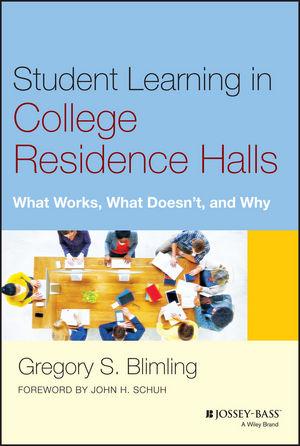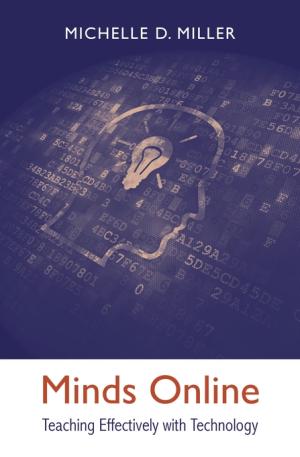Resources by Ashley Lierman

In a higher education climate of ever-increasing competition and demand for accountability, what residence halls can contribute toward institutional learning objectives has never been more important. Blimling’s comprehensive work takes into account not only this fact, but also the multiplicity of potential philosophies and desired outcomes that may guide residence life professionals’ efforts. The result is a nearly exhaustive list of possible approaches to fostering student learning in residence halls, substantiated by results from past studies. Blimling begins with a review of the history of on-campus housing, followed by a description of the major strands of thought in housing and residence life philosophies. In chapters 2 and 3 he moves on to discuss biological and psychological development in college students and how these and other factors impact learning and cognition. Chapter 4 addresses the effects of different types of residence hall learning programs, while chapter 5 takes a brief digression to discuss key considerations when selecting and training residence life staff. Chapter 6 discusses how the structure (physical and otherwise) of residence halls influences students, and chapters 7 and 8 focus on ways residence life staff may shape the social and academic climate of residence halls to promote learning. Chapter 9 provides an in-depth discussion of assessing residence life programs, including strategies for implementing assessments, using the results, and establishing a culture of assessment. The last chapter presents possibilities for the future of residence halls, based on current trends in higher education and residence life. The strength of Blimling’s work lies in its thoroughness, particularly with regard to evidence. The majority of each chapter is occupied with summarizing findings from the literature on various elements of its subject matter; certainly the book lives up to its title’s promise to show “what works, what doesn’t, and why,” in numerous aspects of student housing ranging from the effects of over-long hallways to the ideal size for a study group. The consequence of this intense focus, however, is that it occasionally obscures the broader context of the information. Practical applications are discussed for many individual techniques, but rarely are they generalized into more comprehensive strategies for programs and initiatives. This may be by design, to encourage readers to develop customized programs for their own unique contexts. In practice, however, it makes it somewhat difficult at first to identify the potential utility of the wealth of information in each chapter, let alone in the entire book. It is easy to imagine a residence life professional turning to this work to find evidence that a specific strategy will be effective, but more difficult to imagine one finishing the book with a clear idea of what future directions in programming to pursue. It is also worth noting that this book is written primarily for an audience of residence life professionals, and its usefulness to teaching faculty is limited. The principal exceptions are, as noted in the preface, “higher educational administrators and faculty who work with students in living and learning programs and other educational enrichment programs that operate in residence halls” (xvii-xviii). Faculty in residence will likely find it of interest, as will faculty advisors to, or participants in, living and learning groups in residence halls. For those simply interested in how to better integrate their teaching with residential learning initiatives, however, it will hold less value, as the majority of the work is focused on managing those aspects of student life that affect learning, rather than on designing or delivering educational programs themselves. For these reasons, I would recommend this book to residence life professionals and staff, faculty who participate in student residences, and faculty and graduate students in relevant areas of higher education administration. For all others, however, I would consider it optional.

Do students learn as well online as they do in the face-to-face classroom? Miller argues not only that they can, if the instruction is well-designed, but also that online tools and resources are uniquely able to deliver instructional experiences that take advantage of the innate properties of human learning. “[W]hat technology allows us to do,” she claims, “is amplify and expand the repertoire of techniques that effective teachers use to elicit the attention, effort, and engagement that are the basis for learning” (xii). Miller realizes that many faculty do not share her positive view of technology in instruction, however. She opens her book by targeting that resistance with well-reasoned and supported counterarguments: in chapter 1, she counters the fear that teaching with technology is a faddish, passing phenomenon with a recounting of its potential lasting value to both administrators and instructors; in chapter 2, she presents evidence for the effectiveness of online learning and against typical worries about its effects on students; and in chapter 3, she debunks several major myths about learners and computing that have made instructors skeptical or misdirected their efforts. Having assuaged common concerns about instructional technology, Miller moves on in chapters 4 through 8 to discuss current psychological theory on the functioning of attention, memory, reasoning, the effect of multimedia elements on learning and motivation, paired in each case with practical strategies to help online instruction optimize these elements. Her evidence is compelling even as it is presented at an accessible level for an audience with little to no background in psychology. Finally, in chapter 9, she presents possibly the most valuable portion of the entire work: a demonstration of all of her principles in practice, in the form of a sample design process and syllabus annotated to show their use of cognitive best practices. The value of Miller’s overall guidance is only slightly undermined by its fuzzy definition of learning for these purposes. Even as she describes how technology can impact learning, learning itself seems to be equated variously with retention, course completion, grades, and reasoning at different points in the text. In all fairness, each of these measures may well suffice at times for the instructor of a large introductory psychology class, which is the primary use case Miller discusses in this book; and to her credit, she does acknowledge the limitations of each of these as measures of student learning, and also explicitly notes the need for learning experiences that foster deep critical thought, and that engage students at the highest levels of Bloom’s Taxonomy. Nonetheless, a more intentional definition of what is meant by learning would do a great deal to strengthen her argument that online resources can support it. Despite this limitation, however, this book is a useful, readable guide to an area of instruction whose study is still in its early stages, unusually and gratefully practical even while firmly grounded in theory. It provides a valuable reframing of, and supplement to, the core principles of instructional design, and I expect it to inform my online and even face-to-face instructional practice for some time to come. I would recommend it for any academic library and for the personal collection of any instructor teaching, or considering teaching, in an online or blended environment.